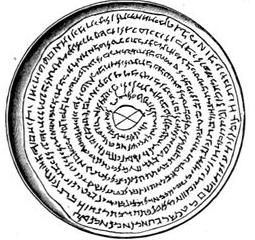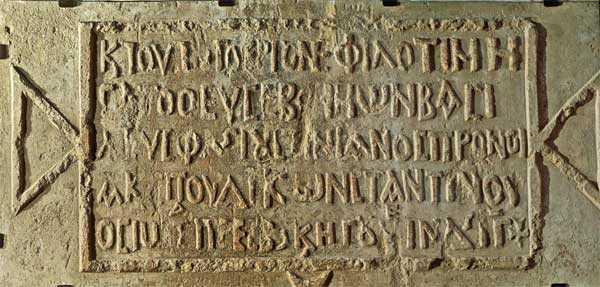Home » Archives for September 2008
Archive for September, 2008
Burial Inscription This Byzantine era Greek inscription found in a burial chamber in Mamilla, west of the Jaffa Gate in Jerusalem states- “For the redemption and salvation of those, God knows their names.” Israel Museum
THE present paper is confined to the consideration of the dates of existing buildings in the city of Jerusalem so far as they can be determined. The oldest existing remains appear to be those of the ramparts of the upper city. It was round this hill (now known to the inhabitants as Sion) that the […]
True Cross Titulus After discovering the true cross, the legend goes, Helena sent a fragment home to her son. The earliest extant version of the legend reads- “Part of the Cross she sent to Constantine but she also left a part in Jerusalem.” By the mid-fourth century, supposed fragments of the cross had been dispersed […]
“A discovery relating to the Jews of the captivity in Babylon, and consequently of great interest to Oriental scholars, and especially to biblical students, was made by Mr. Layard during his second expedition to Assyria. Amongst the various curious objects found on the banks of the Euphrates, and in the ruins of ancient Babylonia, were […]
A cross inlaid with wood suggested to be possibly wood of the True Cross. The cross was discovered in late January, 1997 during the excavation of a sixth-century A.D. house or shop just outside Jerusalem’s Jaffa Gate. Crosses have often been discovered before—Jerusalem has long had a flourishing souvenir industry featuring holy oil, holy water […]
Bowl with Protective Spell for Mahlafta Daughter of Bathabsabba (Magic Bowl) BLMJ 6299 Baked clay with black ink, Mesopotamia Late Sassanian-early Islamic periods 6th-7th centuries CE, Height 6 cm, Diameter 15.8 cm The bowl contains two distinct incantations, separated by a quotation from Zechariah 3-2, one of the biblical verses most frequently quoted in these […]
Sacred Horseman Bronze rings found in a tomb near Caesarea in Israel, dated to the 5th-6th centuries C.E., which depict the sacred Horseman. The Sacred Horseman was one of the most common protective symbols in Byzantine Christianity and often appeared on various types of Jewelry as well as sacred amulets.
Mosaic of Justinian The emperor Justinian (527-565 C.E.) was one of the greatest builders in Byzantine history. One of his most famous building projects was the Nea Church. He is depicted in a sixth-century mosaic from the basilica of San Vitale in Ravenna, Italy. Taylor, Joan, “The Nea Church; Were the Temple Treasures Hidden Here?” […]
Nea Church “In June 1970, preparations were being made for the construction of a dwelling in the court of the Batei Mahse, near the Rothschild House. This complex, founded in the previous century by Jews from Germany, centered around a large courtyard popularly called “Der Deutscher Platz.” A Hebrew newspaper of over a century ago […]
Byzantine Avdat Two churches and service buildings were constructed in the acropolis monastery at Avdat. The more important southern church had three apses on the eastern side. In the floor are reliquaries for the remains of local saints. In the floor of the prayer hall of the church are the tombs of clerical dignitaries. Byzantine […]










